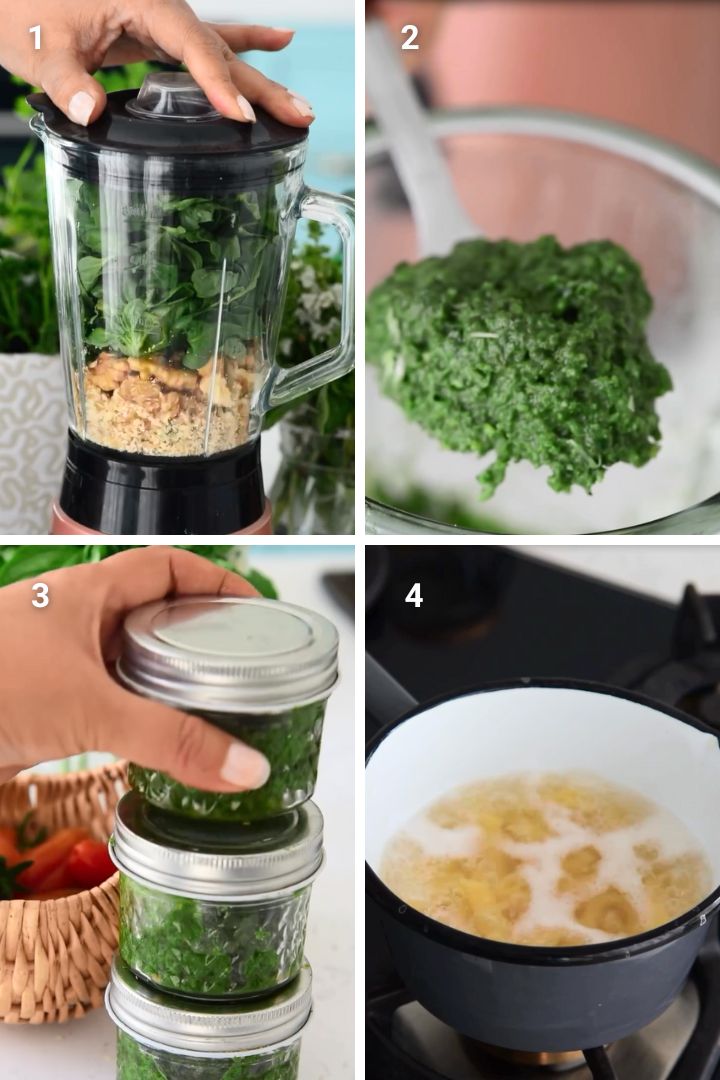If you want to make pasta that is gut friendly, try this gluten- free, homemade pesto pasta . The trick is to use gluten free high protein pasta. In this blog, I will also highlight how you can meal prep for this recipe and also get various meal options. Whether
Why To Make It?
Gut Health Friendly: High-protein gluten-free pasta is easier on digestion and supports gut health. Healthy Alternative: This pasta dish is much lower in carbs compared to regular pasta, so it’s a great choice if you’re looking to avoid sugar spikes. Protein-Packed: You can serve it with grilled paneer, tofu, or boiled eggs for extra protein. Super Simple: The homemade pesto is fresh, easy to make and pairs perfectly with your pasta.
Ingredients
Fresh basil – Provides a bold, fresh flavor and is packed with antioxidants. Olive oil – The healthy fats from olive oil help with nutrient absorption. Parmesan cheese – Adds richness and a savory touch. Walnuts – A great substitute for traditional pine nuts, these add extra crunch and heart-healthy fats. Sea salt – Enhances all the flavors. High-protein, gluten-free pasta – Gut-friendly and ideal for those with gluten sensitivities. Pasta water – Helps create a smooth, clingy sauce. Pistachio powder – Adds texture and flavor. Parmesan cheese – A light dusting of savory goodness. Fresh basil leaves – For that extra pop of color and freshness.
See recipe card for quantities.
Instructions
After washing fresh basil, combine 2 cups of it with 3 tablespoons olive oil, ¼ cup parmesan cheese, ⅓ cup walnuts and a pinch of sea salt. If your blender struggles, scrape down the sides and continue blending until smooth. This makes total 3 small containers of pesto, about 5 tablespoons each. You can store this pesto sauce in fridge and use later as well. Now, boil 1 cup of high-protein, gluten-free pasta according to package instructions and save ¼ cup of the pasta water before draining.
In a large bowl, toss the cooked pasta with 1 tablespoon of the homemade pesto and a little bit of reserved pasta water to create a creamy sauce. Top the pasta with 1 teaspoon of Parmesan Pistachio powder, ½ teaspoon of Parmesan cheese, and a few fresh basil leaves.
Substitutions
Nuts: You can go replace walnuts with pine nuts or almonds for a different flavor and texture. Cheese: If you’re dairy-free, use nutritional yeast instead of Parmesan. Oil: You can substitute olive oil with avocado oil for a different twist.
Variations
Zucchini Noodles: You can use spiralized zucchini, instead of pasta for a low-carbs option. Veggie Boost: Toss in some sautéed spinach, cherry tomatoes, or roasted zucchini for added veggies. Vegan Version: Use vegan cheese or nutritional yeast and pair with grilled Tofu.
Storage
Storing: Leftover pesto can be stored in an airtight container in the fridge for up to a week. The pasta itself is best enjoyed fresh but can be stored in the fridge for 2-3 days. Reheating: To reheat, gently warm the pasta in a pan over low heat, adding a splash of pasta water or olive oil to revive the sauce.
How to serve
This pesto pasta is perfect as a light lunch or dinner. You can serve it alongside grilled paneer or tofu or top it with boiled eggs for added protein. It’s a great dish for meal prep and the pesto itself can be used on sandwiches, salads, or as a dip for veggies!
More Such Recipes
Spinach pesto Pasta Red Sauce Recipe for Pasta and Pizza Four Cheese Pasta Recipe Indian Style Pasta Recipe Tuscan White Beans Pasta Soup Red Sauce Pasta Restaurant style
Watch Video
If You like this recipe and made it Please rate the recipe. It helps us to reach more people. For the Latest updates Subscribe to Rekha’s Whatsapp. You can follow me on Instagram, Facebook, Youtube, Pinterest for more food inspirations.
📖 Recipe



